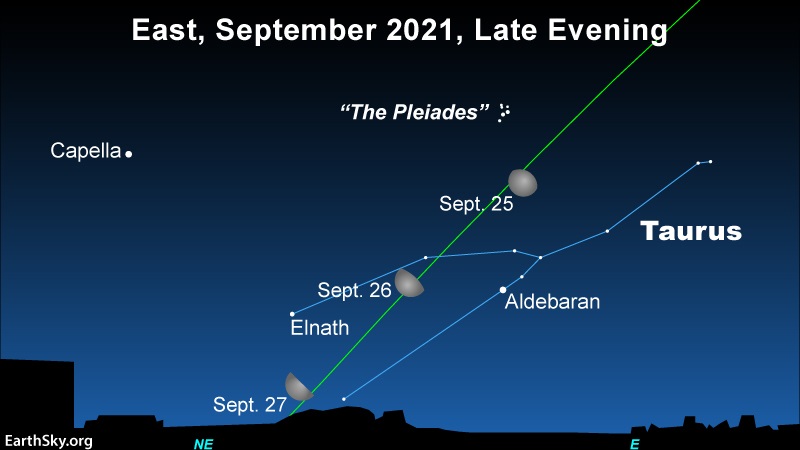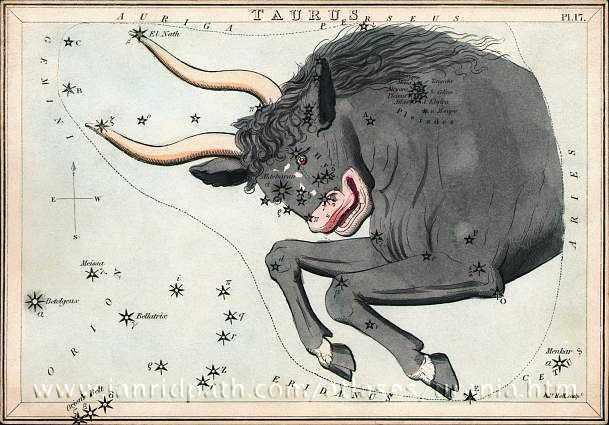
Moon, Aldebaran, Pleiades
Late at night on September 25, 26 and 27, 2021, watch as the waning gibbous moon sweeps in front of the constellation Taurus the Bull. You’ll be looking at late evening, or not much before midnight. The bright moon might make it tough to see the starlit figure of the Bull on these nights. But you should be able to make out Aldebaran, Taurus’ brightest star, as well as the tiny, misty, dipper-shaped Pleiades star cluster.
Then, when the moon moves away, look for the V-shaped Face of the Bull itself. The bright star Aldebaran marks one tip of the V.
Taurus is a far-northern constellation of the zodiac. That fact causes these stars to rise at an earlier hour in the Northern Hemisphere than in the Southern Hemisphere. The farther north you live, the earlier Taurus climbs above your northeast horizon. The farther south you live, the later Taurus comes up.
Also, if you’re not one to stay up late, know that you can view the moon in Taurus before sunup on September 26, 27 and 28. Then they will be higher in the sky.
Want to see your specific sky view? Try Stellarium online
Or visit Sunrise Sunset Calendars, being sure to check the moonrise and moonset box, to find out when the moon rises into your sky.

Moon’s wayward monthly passage through Taurus
When the moon travels in front of Taurus (or any constellation of the zodiac, for that matter), the moon can travel anywhere from 5 degrees north to 5 degrees south of the ecliptic.
A little over three years ago – on September 3, 2018 – the moon occulted (passed in front of) Aldebaran, presenting the final occultation of a monthly occultation series that started on January 29, 2015. But month by month, for the next few years, the moon’s trajectory will carry the moon farther north of Aldebaran yet closer to Alcyone, the Pleiades’ brightest star.
Then the monthly occultation series involving the moon and the Pleiades star Alcyone will begin on September 5, 2023, and conclude on July 7, 2029.
Orion’s Belt points to Taurus

For the Skidi Pawnee in the American Great Plains (Nebraska), the Pleiades cluster served as an important calendar marker. When they saw the Pleiades cluster through the smoke holes of their lodges just before dawn, they knew it was time to harvest the crops.


Bottom line: Are you a night owl? Before bedtime on September 25, 26 and 27, 2021, look eastward for the moon, which shines in front of the constellation Taurus the Bull.
The post Moon, Aldebaran, Pleiades late night September 25 to 27 first appeared on EarthSky.
from EarthSky https://ift.tt/3EPoxQY

Moon, Aldebaran, Pleiades
Late at night on September 25, 26 and 27, 2021, watch as the waning gibbous moon sweeps in front of the constellation Taurus the Bull. You’ll be looking at late evening, or not much before midnight. The bright moon might make it tough to see the starlit figure of the Bull on these nights. But you should be able to make out Aldebaran, Taurus’ brightest star, as well as the tiny, misty, dipper-shaped Pleiades star cluster.
Then, when the moon moves away, look for the V-shaped Face of the Bull itself. The bright star Aldebaran marks one tip of the V.
Taurus is a far-northern constellation of the zodiac. That fact causes these stars to rise at an earlier hour in the Northern Hemisphere than in the Southern Hemisphere. The farther north you live, the earlier Taurus climbs above your northeast horizon. The farther south you live, the later Taurus comes up.
Also, if you’re not one to stay up late, know that you can view the moon in Taurus before sunup on September 26, 27 and 28. Then they will be higher in the sky.
Want to see your specific sky view? Try Stellarium online
Or visit Sunrise Sunset Calendars, being sure to check the moonrise and moonset box, to find out when the moon rises into your sky.

Moon’s wayward monthly passage through Taurus
When the moon travels in front of Taurus (or any constellation of the zodiac, for that matter), the moon can travel anywhere from 5 degrees north to 5 degrees south of the ecliptic.
A little over three years ago – on September 3, 2018 – the moon occulted (passed in front of) Aldebaran, presenting the final occultation of a monthly occultation series that started on January 29, 2015. But month by month, for the next few years, the moon’s trajectory will carry the moon farther north of Aldebaran yet closer to Alcyone, the Pleiades’ brightest star.
Then the monthly occultation series involving the moon and the Pleiades star Alcyone will begin on September 5, 2023, and conclude on July 7, 2029.
Orion’s Belt points to Taurus

For the Skidi Pawnee in the American Great Plains (Nebraska), the Pleiades cluster served as an important calendar marker. When they saw the Pleiades cluster through the smoke holes of their lodges just before dawn, they knew it was time to harvest the crops.


Bottom line: Are you a night owl? Before bedtime on September 25, 26 and 27, 2021, look eastward for the moon, which shines in front of the constellation Taurus the Bull.
The post Moon, Aldebaran, Pleiades late night September 25 to 27 first appeared on EarthSky.
from EarthSky https://ift.tt/3EPoxQY

Aucun commentaire:
Enregistrer un commentaire